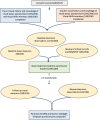In-school eyecare in special education settings has measurable benefits for children's vision and behaviour
- PMID: 31369627
- PMCID: PMC6675062
- DOI: 10.1371/journal.pone.0220480
In-school eyecare in special education settings has measurable benefits for children's vision and behaviour
Erratum in
-
Correction: In-school eyecare in special education settings has measurable benefits for children's vision and behaviour.PLoS One. 2019 Sep 5;14(9):e0222300. doi: 10.1371/journal.pone.0222300. eCollection 2019. PLoS One. 2019. PMID: 31487320 Free PMC article.
Abstract
Objectives: To determine whether implementation of comprehensive in-school eyecare results in measurable benefits for children and young people in terms of visual status, classroom behaviours and how well their visual needs are met.
Design: School-based observational study.
Participants & methods: 200 pupils [mean age 10 years 9 months, 70% male, majority moderate (40%) or severe (35%) learning difficulty] of a special education school in the UK. A sector-agreed in-school eyecare framework including full eye examination and cycloplegic refraction, dispensing of spectacles (as appropriate) and written reporting of outcomes to parents/teachers was applied. Classroom behaviours were observed and recorded prior to, and after, the in-school eyecare. Surveys were employed to obtain visual histories from parents/teachers. School records and statutory documents were reviewed for diagnostic and learning disability classifications. Visual function and ocular health were profiled at baseline and significant visual deficits identified. Where such deficits were previously unrecognised, untreated or not compensated for (e.g. correction of refractive error, enlargement of educational material) they were recorded as 'unmet visual need'. At follow-up, 2-5 months after initial (baseline) measures, eye examinations, parent/teacher surveys and behaviour observations were repeated. Follow-up measures were used to determine if measurable improvements were evident in visual function, ocular health, the level of unmet need and classroom behaviour following implementation of in-school eyecare.
Results: 199 participants completed baseline and follow-up measures. 122 (61%) participants presented with at least one significant visual or ocular health deficit and 90 (45%) participants had at least one unmet visual need. Younger pupils and those with no previous history of eyecare were more likely to demonstrate unmet visual needs at baseline (OR 1.12 95% CI 1.03 to 1.21) p = 0.012; (OR 4.44 95% CI 1.38 to 14.29 p = 0.007 respectively). On follow-up, the number of pupils with unmet visual needs dropped significantly to 36 (18%) (McNemar's test p<0.001). Visual and behavioural metrics of participants without significant visual deficits or whose visual needs were adequately addressed at baseline remained relatively unchanged between baseline and follow-up (Wilcoxon signed rank p>0.05). Where significant refractive deficits were corrected at follow-up, near visual acuity improved significantly (Wilcoxon signed rank p = 0.013), however, poor spectacle compliance was a persistent cause of unmet visual need. Off-task behaviour reduced significantly after actions to address unmet visual needs were communicated to parents and teachers (Wilcoxon signed rank p = 0.035).
Conclusions: The present study demonstrates for the first time measurable visual and behaviour benefits to children in special education settings when they receive comprehensive in-school eye examinations, on-site spectacle dispensing and jargon-free reporting of outcomes to teachers and parents.
Conflict of interest statement
The authors have declared that no competing interests exist.
Figures
References
Publication types
MeSH terms
LinkOut - more resources
Full Text Sources
Medical
Miscellaneous


